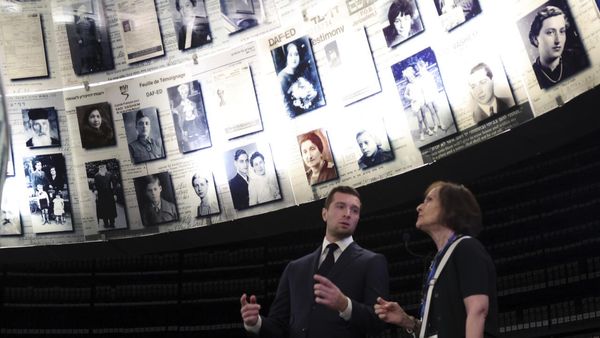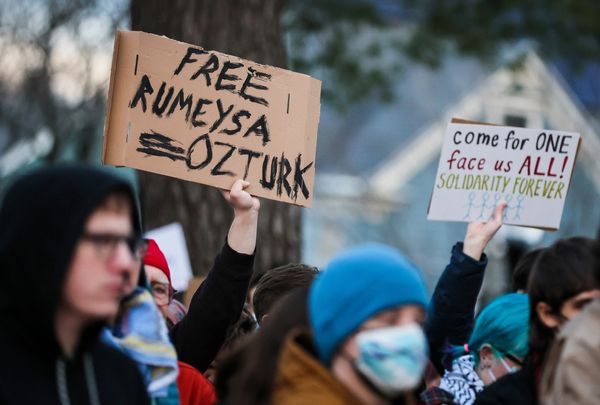
When Andy Warhol and Jean-Michel Basquiat’s debut show of collaborative paintings premiered in 1985, it was panned by the critics. Notoriously, the New York Times’s Vivien Raynor labelled the twentysomething street artist Basquiat a “mascot” for the ageing pop art pioneer Warhol. The critical reaction drove the artists apart and they barely spoke again before Warhol’s death only 18 months later. Just three years after the exhibition, Basquiat would also be dead at 27 from a heroin overdose.
The last time I spoke to Broadway star Jeremy Pope, in early 2020, he was promoting his debut major TV role in Ryan Murphy’s Hollywood, a big, brassy reimagining of 1940s Tinseltown. He was softly spoken but palpably excited, even in the midst of the rapidly developing pandemic. Once the reviews started to come in, Hollywood – like Warhol and Basquiat’s show – was the subject of a critical thumping. The Guardian labelled it a “crushing disappointment” for its revisionism of 1940s Tinseltown, while Variety deemed it a show with “little worth saying”.
Two years on, Pope is speaking to me over video call, framed by a pair of loud, mushroom-patterned curtains that have been provided as part of his digs on London’s South Bank. He is in town for the next three months playing Basquiat in a new play by The Two Popes writer Anthony McCarten, directed by the Young Vic’s artistic director Kwame Kwei-Armah. The play, The Collaboration, tells the story of that ill-fated 1985 exhibition and co-stars Paul Bettany as Warhol.

So, how was it reading the Hollywood reviews and then inhabiting Basquiat during his own critical turmoil? “I’m a Cancer, so I’m sensitive,” Pope says with a smile. He seems careful to remain magnanimous, lest the critics have something to latch on to. “We do what we do because we love it and I think that should be good enough, rather than being based on someone’s subjective opinion.” He pauses. “But that’s what art is, it is a conversation. Regardless of what someone says, you have to show up the next day and tell that story on stage because you believe in it. I choose to hope that one person is affected in a positive way [by Hollywood], the same way I was affected when I read the script.”
Pope is no stranger to accolades, just as he is to criticism. Back-to-back lead roles in Moonlight writer Tarell Alvin McCraney’s tale of self-discovery, Choir Boy, and Ain’t Too Proud, a jukebox musical about the Temptations, earned him two nominations at the 2019 Tony awards. It made him only the sixth person in the 73-year history of the Tonys to be up for two gongs in one season.
To tackle Basquiat, though, is a new challenge. “He was a mysterious soul whose image and images are so available, but the person behind them can be an enigma,” Pope says. Rather than get bogged down in the biographies, Pope has instead been turning to Basquiat’s art as the key to understanding the man. “There was such a direct connection from his mind and his heart to the canvas. It seems the most honest and most true expression of him.”

If Basquiat is an enigma, so is his relationship with Warhol. The pair first met while Basquiat was a teenager in the early 80s, frequenting Warhol’s Factory studio and trying to get a glimpse into its celebrity social set. A lunch date set up by the art dealer Bruno Bischofberger in 1982 then sparked the beginnings of a friendship and collaboration that would span the next three years.
Warhol had seen his star wane throughout the 1970s, while Basquiat was the subverting street artist recently brought into the gallery world and primed to deliver new intrigue. It made for a potent combination, one that the artist Keith Haring described as “each [artist] inspiring the other to outdo the next”. Speculated as being either a vampiric attempt by an older artist to maintain relevance, or the tale of a mentorship sullied by public disapproval, playing such a complex dynamic could surely bring its own complications between Pope and his onstage sparring partner Bettany?
“I’m not just saying this because we’re currently living across the hall from each other, but Paul has been such a light and has embraced me in a way that isn’t required for work,” he says. “We have both committed to playing these men and we’re digging deep – when we’re not rehearsing, we’re spending evenings going through the script and getting to the heart of the relationship.”
It is a steadfast connection they will be exploring for some time to come – the play has already been picked up for a film adaptation, with the pair reprising their roles – and one that Pope believes Basquiat and Warhol also once had. “There was so much love in their relationship,” he says. “There are so many photos of them just clowning together or getting pedicures and you can’t deny that there was a true foundation of friendship and respect for each other.”

So how did a handful of reviews then prompt Basquiat to stop visiting Warhol for their regular painting sessions at the Factory, and for the pair to ultimately stop speaking before Warhol’s sudden death in 1987? “Because what people say and how they view you determines how you can provide for yourself, especially for Jean as a Black man trying to make it in a white art world,” Pope says.
That pressure of maintaining relevance as a minority artist is something that Pope relates to today. “There is a cost to being an artist and it is carrying the weight of the Black and queer communities I represent,” Pope says. “It can feel heavy acknowledging that responsibility. Often I wonder, am I doing enough? Or, how can I do more?” And it was the proliferation of these questions that Pope believes led to Basquiat’s own downfall. “His addiction began because there was this pressure to stay relevant and it wasn’t about fame; it was about having a stake in the conversation and being seen,” he says.
For Pope, though, it is in the work of playing others that he comes to a sense of solace in himself. “I’m in the healing business, since art can heal and change the way that you think,” he says. “Playing Jean has made me feel free, which is a beautiful thing as an artist. I feel taken care of and I just hope that people who come to see us can feel loved or healed, too.”
And what of those pesky critics? “This experience is something that I’ll cherish for ever – it has been fucking thrilling,” Pope says. “No review can change that.”
The Collaboration is at the Young Vic, London, to 2 April.
***
Brushes with genius
Jonathan Jones selects his favourite dramatic representations of artists
Doctor Who: Vincent and the Doctor (2010)

Tony Curran is a genuinely believable Van Gogh in this moving Doctor Who story. The Doctor and Amy can’t change history to stop his suicide but take him to today’s Musée d’Orsay, where he hears Bill Nighy’s critic praise him as one of the greatest artists ever. Tears.
Frida (2002)

Salma Hayek broke away from conventional roles to play the visionary Mexican artist in a film that aches to do justice to her pain, disabilities and defiance. Julie Taymor’s direction is sometimes too pretty for its own good but Hayek does imagine her way into being Kahlo, in all her rage and generosity.
Mr Turner (2014)

It took the quirky originality of writer-director Mike Leigh to find dramatic material in the private, ungiving character of English landscape painter JMW Turner. But Timothy Spall brilliantly inhabits this fish out of water in Regency society, a working-class genius in a posh milieu.
Red (first performed 2009)

The profoundly unhappy abstract expressionist Mark Rothko is another difficult character to fictionalise but John Logan’s play focuses on a spectacular emotional turning point, when a commission to decorate a Manhattan restaurant drove the painter (in a role first played by Alfred Molina) into agonies of moral disgust.
Caravaggio (1986)

There are some accidentally comic moments in Derek Jarman’s deliberately Brechtian and unrealistic life of the painter and murderer who took baroque Italy by storm, but Nigel Terry’s Caravaggio and his model, played by Sean Bean, make the artist’s queer courage explicit as he negotiates Rome’s palaces and mean streets.







